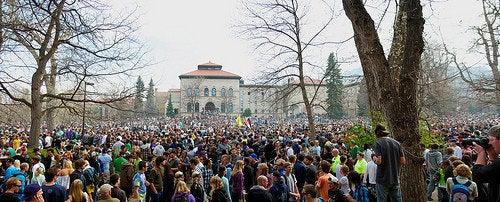
Earlier this week CNN/Opinion Research released a series of national polls that seemed to represent young Americans (under the age of 35) marginally at best, if at all. Specifically, they listed respondent data on questions pertaining to "the legalization of marijuana" and "marriages between gay and lesbian couples" as N/A (not available) from the 18-34 age demographic.
To the average person -- N/A would appear to mean that they did not pursue, could not reach, or did not obtain enough responses from Americans under age 35 to constitute statistical significance. And in response, my organization, OUR TIME (ourtime.org), which stands up for the economic and civic interests of young Americans, released a petition -- "N/A is not OK" -- to show CNN that they have a responsibility to survey our age cohort proportionately when conveying public opinion news.
Our "N/A is not OK" petition obtained more than 2,500 signatures in less than 12 hours, and hundreds of OUR TIME members conveyed their frustration with the polling process on Facebook and Twitter. In fact, the digital activism of OUR TIME members in addition to that of other groups, such as GetEQUAL, who highlighted the poll, warranted a response from Keating Holland, CNN's polling director.
Keating ballparked that roughly 9-10 percent of the 824 poll respondents were under the age of 35, but refused to release the raw number of young survey respondents. CNN also issued the following statement:
The 18-34 year-old age group is included in all surveys conducted and released by CNN. The group was also included in the poll released on Tuesday, April 19, 2011. The data for the 18-to-34 age group is listed as "N/A" in the breakdown of age groups because the sample size was too small for statistically valid analysis. CNN polls, like all other polls conducted by news organizations, adjusts many groups to reflect their actual share of the total adult population as reported by the U.S. Census, so the overall results are unaffected by the small number of 18-to-34 year olds interviewed.
OUR TIME told CNN that there are more than 70 million Americans between the ages of 18-34 and this age group represents more than 30 percent of the adult population over 18. Thus, if the CNN poll was to interview young Americans proportionately to their size in the population -- they would have surveyed roughly 247, not the roughly 74-82 that would comprise the 9-10 percent they cited. Instead, during my call with Keating it became clear to me that they had to weight the poll so that each young American polled was multiplied by three. Meanwhile Keating informed me that citizens over the age of 65 responded to the poll in such high numbers that CNN underweighted them to make the overall results representative.
In essence: 70 million young Americans were poorly represented because the sample size was too small to be meaningful. This information illustrates a larger societal problem in how we speak for younger generations, and Keating and I ended our call yesterday in amicable agreement that OUR TIME and CNN should collaborate in the future to explore ways that we can make public opinion data more indicative of young voices.
OUR TIME regrets that a part of our messaging was technically inaccurate regarding the "exclusion" of young respondents. We would like to amend any statements that claim no people under the age of 35 were included in the poll to reflect that those who were contacted were too few to indicate reliably the views of 70 million young Americans.
What's more important are the following takeaways:
1) Perception often becomes reality, and when N/A is listed in public opinion polls, it appears that negligible data is available for specific demographics. Media outlets have a responsibility to explain how and to what degree these polls are weighted.
2) This practice is not specific to CNN, but is common in the entire polling industry, and as we head into 2012, OUR TIME will highlight the importance of reaching young Americans -- whether by cell phone or through internet outreach.
3) The polling industry must innovate -- Americans under 35 are not contacted in 2011 in the same way it was done in 1981 -- before there were cell phones and social media outlets. Multimillion dollar news outlets must make the investment to reach our demographic in order to reflect public opinion accurately. The commercial world can reach us. It is not too much to expect the polling industry to be able to reach us.
We invite Keating Holland, polling analysts such as Nate Silver, and other leading pollsters to work with OUR TIME to make polls truly representational samples of young people and call on OUR TIME members to propose solutions around ways to increase accessibility to our generation.